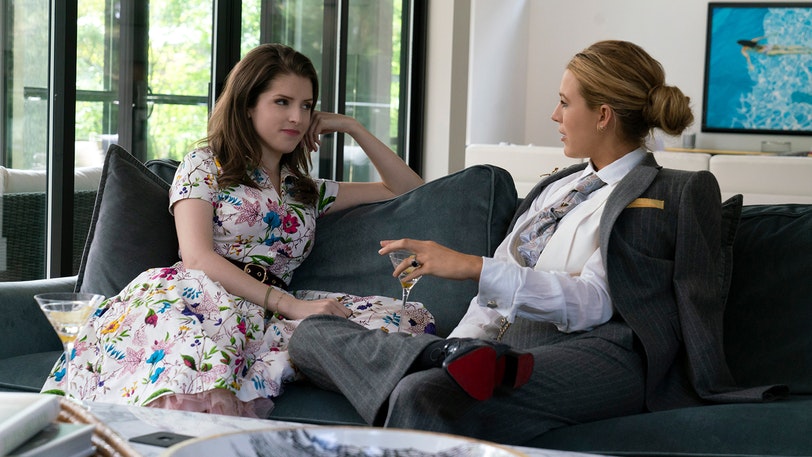FYC: "A Simple Favor" for Best Costume Design
 Monday, January 14, 2019 at 3:47PM
Monday, January 14, 2019 at 3:47PM Please welcome new contributor Mark Brinkerhoff

A simple favor to ask members of the Academy (its costume branch, in particular): don’t miss your opportunity to nominate A Simple Favor, simply one of the finest showcases of contemporary costuming in years. How so? Let’s examine.
First off, it’s only natural to zero in on Blake Lively’s character’s frankly stunning series of sharply-tailored suits with vertiginous stilettos. But while my own love of ladies in menswear knows no limits there is much more happening front and center (Anna Kendrick) and around the margins (Linda Cardellini, Jean Smart, Lively’s other character) to pique the interest of sartorially-minded viewers...

Take Kendrick. Showing a love of prints (floral), patterns (polka dots), and comfy materials (denim—both jackets and skirts), what we get with her is a character who’s as much playing a part in her own life (mommy vlogger, mommy period) as she is getting dressed for the quotidian needs of suburban life. Crisp, clean, high-waisted or belted. Dainty jewelry, a simple watch, and chunky heels. It’s character-building costuming.
If you believe in the notion of costume as character, A Simple Favor illustrates that beautifully—and forcefully. The clothing and accessories of its two leading ladies alone approach the echelons of The Devil Wears Prada and Sex and the City. In fact, you can easily envision Blake Lively’s character as a former assistant of Ms. Miranda Priestley (the ill-fated one who sliced her hand with a letter opener, perhaps?).
But back to Kendrick. That her demure, almost-Laura Ashley-looking ensembles at the beginning of the film undergo a riskier, sexier evolution toward the end mirrors the arc and experiences of a woman craftier than she appears. And her clothing choices contrast nicely with Lively’s, mostly all vertical lines to Kendrick’s more horizontal ones. It’s almost as if Lively’s and Kendrick’s characters’ dress is designed to accentuate the seemingly Amazonian height differential between the two.

When we actually do see Lively’s character in dramatic color, it’s usually an accent within her otherwise black and white (or navy and white, or shades of white) suits. This makes the unexpected bursts of color — fuchsia gloves! a mustard-colored pocket square! — or accessories (a watch fob, a cane for Christ’s sake) really pop. Her sole frilly dress, meanwhile, is a comparatively muted light blue with magnolia flowers over a pale pink petticoat. It doesn’t scream “beware!” but it's a fishy departure nonetheless.
Also worth noting is Cardellini’s look in her cameo. Less grungy than deliberately artsy, her heavy metal t-shirt (plus kohl-rimmed eyes and side-swept hair) connotes a somewhat sapphic bent right off the bat, without leaning too hard into obvious stereotypes. All in all, this isn’t a film that’s afraid of color: from Lively’s shocking pink hair in flashbacks to Smart’s character’s various shades of purple (velour, no less) in the present.
While the few men in the film get short shrift, clothing-wise, I should mention Henry Golding’s character’s. Although relegated to Banana Republic-y jeans, button-down shirts, v-neck sweaters, and light jackets, his wardrobe is in keeping with the relatively bland slightly misleading nature of the character himself. In that sense, it works.

With Oscar voting closing today, consider the ample evidence that makes A Simple Favor a compelling case for a Best Achievement in Costuming nomination. Though the Costume Designers Guild, which actually has an entire category dedicated to achievement in contemporary film, failed to nominate A Simple Favor (in favor of…Mamma Mia! Here We Go Again?), we can hold out hope that justice will be served come Oscar nomination morning.



Reader Comments (3)
Yes, yes, a thousand times yes.
I mean,the way that first suit Blake wears deconstructs so amazingly and reveals much about the character as she removes each piece. The best.
Oh, I agree, Bia. I was sold on this movie as soon as she revealed—removed?—her wristlets.